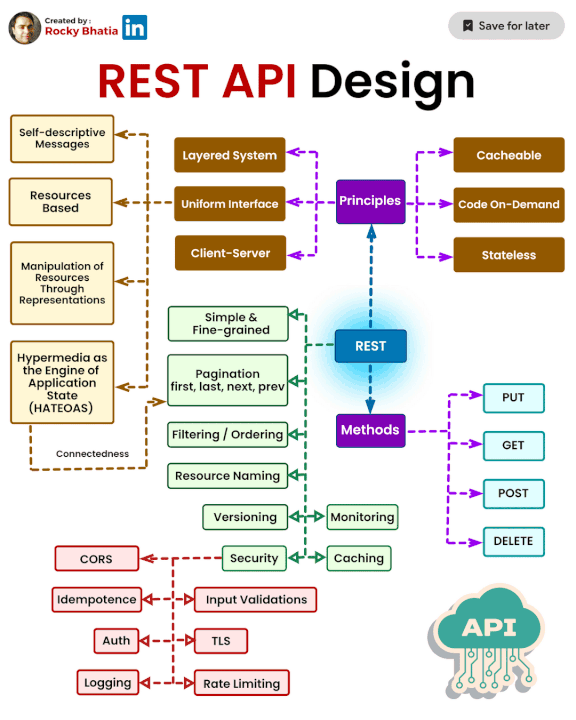In the rapidly evolving realm of technology, where seamless communication between applications is the key to innovation, Application Programming Interfaces (APIs) have emerged as the linchpin. They define the rules for software applications to interact with one another, enabling the exchange of data and functionalities. Among the myriad of API types, REST (Representational State Transfer) APIs stand out for their simplicity, scalability, and widespread adoption.
Understanding APIs and REST:
APIs act as the conduits that empower developers to integrate different systems, enhance functionalities, and create innovative solutions. They facilitate the exchange of data, allowing applications to communicate and collaborate. REST APIs, specifically, have gained immense popularity due to their flexibility, ease of use, and stateless nature.
APIs serve as the building blocks that empower developers to integrate diverse systems, enhance functionality, and create innovative solutions. They enable the seamless exchange of data, allowing applications to communicate and collaborate. REST APIs, in particular, have gained immense popularity due to their flexibility, ease of use, and stateless nature.
REST API Design Principles:
- REST Methods: REST APIs utilize standard HTTP methods for communication, each serving a specific purpose: GET retrieves a resource, POST creates a new resource, PUT updates a resource, and DELETE removes a resource.
- Cacheable: REST APIs are designed to be cacheable, allowing responses to be stored and reused, thereby reducing the need for repeated requests to the server and improving performance.
- Code On-Demand: Although optional, this principle allows clients to download and execute code, enhancing the flexibility of the system.
- Stateless: REST APIs are stateless, meaning each request from a client contains all the information needed to understand and fulfill it. The server does not store any state about the client between requests.
- Simple & Fine-Grained: The design of the API should be simple, offering fine-grained control over resources. Each resource should have a unique identifier and be manipulated independently.
- Pagination (first, last, next, prev): To handle large datasets, APIs should support pagination, allowing clients to retrieve data in manageable chunks.
- Filtering / Ordering: REST APIs should provide mechanisms for clients to filter and order data according to their requirements, enhancing the flexibility of data retrieval.
- Connectedness: Resources should be interconnected, promoting discoverability and providing links to related resources, aiding navigation within the API.
- Resource Naming: Resources should be named using meaningful and consistent URIs, reflecting the nature of the data they represent and promoting clarity in the API structure.
- Versioning: APIs should support versioning to manage changes and updates without breaking existing client implementations, ensuring backward compatibility.
- Security: Implement secure authentication and authorization mechanisms to protect sensitive data and ensure secure communication, safeguarding the API against unauthorized access.
- Self-Descriptive Messages: Responses from the server should include metadata that describes how the client can process the data, fostering better understanding and utilization of the API.
- Resources Based Manipulation Through Representations: Clients interact with resources through representations, allowing manipulation through well-defined formats such as JSON or XML, promoting interoperability.
- Hypermedia as the Engine of Application State (HATEOAS): HATEOAS allows clients to navigate a REST API by following links in resource representations, reducing the dependency on documentation and promoting a self-discoverable API.
- Layered System: A REST API should be designed as a layered system, promoting modularity and ease of maintenance, where each layer has a specific responsibility.
- Uniform Interface: A uniform and consistent interface simplifies the architecture and improves the overall user experience, enabling clients to understand and interact with the API seamlessly.
- Client-Server: Separation of concerns between the client and server enables each to evolve independently, facilitating scalability and flexibility in the system architecture.
- Caching: Implementing caching mechanisms can significantly improve performance by reducing the load on the server, enhancing the overall responsiveness of the API.
- CORS (Cross-Origin Resource Sharing): Allow controlled access to resources from different domains, ensuring security while enabling cross-origin requests and broadening the accessibility of the API.
- Idempotence: Operations should be idempotent, meaning that performing the same operation multiple times produces the same result as performing it once, ensuring predictability and consistency.
- Authentication (Auth): Secure your API by implementing robust authentication mechanisms, such as API keys, OAuth, or JWT, safeguarding sensitive data.
- Logging: Maintain detailed logs to monitor API usage, diagnose issues, and enhance overall system reliability, providing valuable insights for troubleshooting and optimization.
- Input Validations: Validate input data to ensure data integrity and prevent security vulnerabilities, enhancing the robustness of the API.
- TLS (Transport Layer Security): Encrypt communication between the client and server using TLS to protect against data interception and tampering, ensuring the confidentiality and integrity of data in transit.
- Rate Limiting: Implement rate limiting to prevent abuse, ensuring fair usage of API resources and maintaining system performance, preventing overuse and ensuring equitable access.
In the intricate tapestry of software development, the creation of an effective and efficient REST API is an art form. The principles outlined above serve as a comprehensive guide for architects and developers, steering them towards the design of APIs that are not only robust and scalable but also capable of seamlessly integrating with diverse systems. As technology continues to advance, the significance of well-designed REST APIs will only grow, shaping the interconnected landscape of the digital world. By adhering to these principles, developers can unlock the true potential of REST APIs, fostering innovation and driving the evolution of modern applications.

?I help Businesses Upskill their Employees in Data Science Technology - AI, ML, RPA
10 个月Great insights on Rest API design, Rocky! Your expertise in this area is truly inspiring. Keep sharing your valuable knowledge!
Software Engineering | .NET Developer
10 个月That's clear and straight forward!??
IT Platform and Product Management
11 个月PATCH
Engagement Delivery Partner at Cognizant
11 个月Excellent articles, sir
Software Engineer @Technosoft | Ex-Wipro | Next Js | React Js | Spring Boot | Microservices | REST API | AWS EC2 | AWS EKS | Competitive Programmer
11 个月Great Share